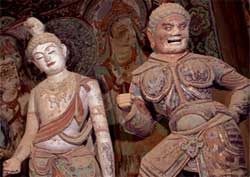Mogao Caves
 Why the
Mogao Caves
are special
Why the
Mogao Caves
are specialThe man made Mogao Caves contain over 40,000 colorful wall art. If laid side by side, they would extend 30 kilometers (20 miles). The Mogao Caves also contain thousands of painted statues (see photo) and scholarly scrolls.
Mogao Caves tips and insights
How to pronounce
Magao: Mah-gow'oh
History in brief
-
Early centuries
The Mogao cave art (mainly Buddha related) first appeared in the 4th century and continued, with some interruptions, over the next thousand years.
- Obscurity
For a long period, many of the Mogao Caves were sealed and forgotten. And, few people beyond the locals knew of the existence of the accessible caves.
- Scholarly pillage
About one hundred years ago Western World museums and art dealers became aware of the artistic treasures. Soon, they and their Chinese agents began exporting many of the irreplaceable scrolls to the West. Fortunately, nearly all the wall drawings and painted statues were left behind.
The wall paintings have retained much of their bright hues because of the dry desert climate.
Cave 96
Only several dozen of the 492 existing Mogao Caves are open to the general public (for preservation purposes). However, most of the allowed caves are remarkable, especially Cave 96. This multi-stored cavern houses a stunning 33 meter (110 foot) high statue of Buddha.
Faiths
Although most of the artwork and scrolls relate with Buddha, some encompass other religious and philosophical persuasions including Confucianism and Taoism.
Silk Road
The caves are on the fabled Silk Road trade route that once commercially linked China and Europe.
Names
The Mogao Caves are also known as the "Mogao Grottoes," "Dunhaung Caves" and the "Caves of a Thousand Buddhas".
Nearest major airport
The Mogao Caves are 25 kilometers (15 miles) from the desert oasis town of Dunhaung (which has an airport) in Gansu province.


